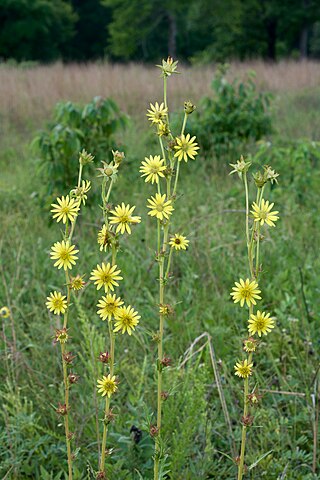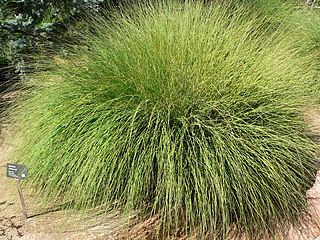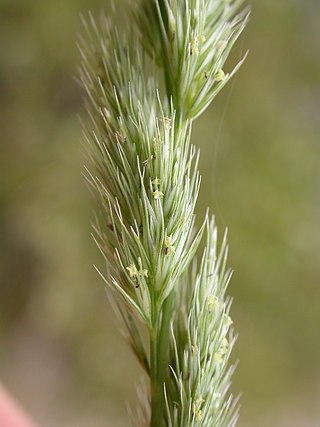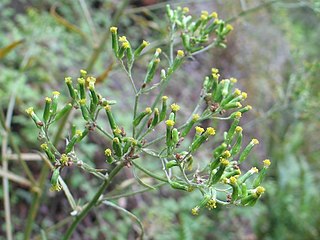
Silphium laciniatum is a species of flowering plant in the family Asteraceae known commonly as compassplant or compass plant. It is native to North America, where it occurs in Ontario in Canada and the eastern and central United States as far west as New Mexico. Other common names include prairie compass plant, pilotweed, polarplant, gum weed, cut-leaf silphium, and turpentine plant. It is a rosinweed of genus Silphium.

Bidens frondosa is a North American species of flowering plant in the aster family, Asteraceae. It is widespread across much of Canada, the United States, and Mexico It is known in many other parts of the world as an introduced species, including Europe, Asia, Morocco, and New Zealand. Its many common names include devil's beggarticks, devil's-pitchfork, devil's bootjack, sticktights, bur marigold, pitchfork weed, tickseed sunflower, leafy beggarticks, and common beggar-ticks.

Muhlenbergia schreberi, the nimblewill, is a grass species in the family Poaceae native to North America.

Cotinis nitida, commonly known as the green June beetle, June bug or June beetle, is a beetle of the family Scarabaeidae. It is found in the eastern United States and Canada, where it is most abundant in the South. It is sometimes confused with the related southwestern species figeater beetle Cotinis mutabilis, which is less destructive.

Muhlenbergia is a genus of plants in the grass family.

Anguina agrostis is a plant pathogenic nematode.

Solidago nemoralis is a species of flowering plant in the family Asteraceae. It is native to North America, where it is widely found in Canada and the United States. Its common names include gray goldenrod, gray-stem goldenrod, old-field goldenrod, field goldenrod, prairie goldenrod, dwarf goldenrod, and dyersweed goldenrod.

Muhlenbergia mexicana, known by the common names Mexican muhly and wirestem muhly, is a species of grass. It is native to North America, including most of the United States and southern Canada. It actually does not occur in Mexico.

Muhlenbergia porteri is a species of grass known by the common names bush muhly and Porter's muhly.

Muhlenbergia richardsonis, known by the common name mat muhly, is a species of grass. It is native to North America, where it can be found throughout much of Canada, Alaska, the western half of the contiguous United States through California, and in Baja California, Mexico.

Muhlenbergia cuspidata is a species of grass known by the common name plains muhly. It is native to North America where it is distributed across central Canada and the central United States.

Muhlenbergia glomerata is a species of grass known as spiked muhly and marsh muhly. It is native to North America, where it occurs across Canada and the northern half of the United States.

Muhlenbergia racemosa is a species of grass known by the common names green muhly and marsh muhly. It is native to North America, where it is most common in the north-central United States. It also occurs in the western United States and northern Mexico.

Hilaria mutica, synonym Pleuraphis mutica, is a species of grass known by the common name tobosa, or tobosa grass. It is native to Northern Mexico, and the Southwestern United States, in Arizona, New Mexico, Oklahoma, and Texas.

Muhlenbergia torreyana is a species of grass known by the common names New Jersey muhly, Torrey's muhly, and Torrey's dropseed. It is native to the eastern United States, where today it occurs in Maryland, New Jersey, North Carolina, and Tennessee. It has been extirpated from Delaware, Georgia, and New York.

Muhlenbergia capillaris, commonly known as the hairawn muhly, is a perennial sedge-like plant that grows to be about 30–90 cm (0.98–2.95 ft) tall and 60–90 cm (2.0–3.0 ft) wide. The plant includes a double layer; green, leaf-like structures surround the understory, and purple-pink flowers outgrow them from the bottom up. The plant is a warm-season grass, meaning that leaves begin growth in the summer. During the summer, the leaves stay green, but they morph during the fall to produce a more copper color. The seasonal changes also include the flowers, as they grow out during the fall and stay healthy till the end of autumn. The muhly grows along the border of roads and on plain prairies. The grass clumps into herds, causing bush-like establishments in the area the hairawn muhly inhabits. The flowers are very feathery and add a cloudlike appearance to the top of the grass. It is native to eastern North America and can be used for a multitude of purposes, including ornamental gardening and farming. It was voted 2012 plant of the year by the Garden Club of America.

Muhlenbergia lindheimeri is a species of bunch grass, 3-6' H, known by the common names big muhly, blue muhly, and Lindheimer's muhly. It is native to North America, where it can be found in northern Mexico and up to the Edwards Plateau region of Texas. It is also grown as an ornamental grass. as it is useful as a green screen, erosion control, water retention and nest material for many species of birds

Senecio minimus, commonly known as toothed fireweed and coastal burnweed, is a species of plant in the sunflower family. It is native to Australia and New Zealand, and also naturalized on the Pacific Coast of the United States.


















